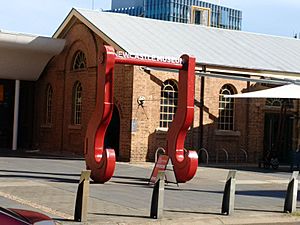Honeysuckle Point Railway Workshops facts for kids
Quick facts for kids Honeysuckle Point Railway Workshops |
|
|---|---|

Newcastle Museum at the railway workshops, 2018
|
|
| Location | Newcastle, City of Newcastle, New South Wales, Australia |
| Built | 1874–1886 |
| Architect | John Whitton |
| Owner | Hunter Development Corporation; Newcastle City Council |
| Official name: Civic Railway Workshops; Honeysuckle; Industrial Archaeological Site; Newcastle Museum | |
| Type | state heritage (complex / group) |
| Designated | 2 April 1999 |
| Reference no. | 956 |
| Type | Railway |
| Category | Transport - Rail |
| Builders | Dart & Parkhill (Boiler House & Machine Shop) |
| Lua error in Module:Location_map at line 420: attempt to index field 'wikibase' (a nil value). | |
The Honeysuckle Point Railway Workshops were once a very important place in Newcastle, Australia. This site used to be a big workshop where trains were built and fixed. A famous architect named John Whitton designed them. They were built between 1874 and 1886.
These workshops are also known as Honeysuckle Railway Workshops or Civic Railway Workshops. Today, the Newcastle Museum is located here! Because they are so important to history, they were added to the New South Wales State Heritage Register in 1999.
Contents
A Look Back in Time
Let's explore the history of the Honeysuckle Point Railway Workshops:
- Around 1840: Land was bought at Honeysuckle Point for a church school.
- 1848: The Dangar family started Newcastle's first cannery (a place that cans food) nearby.
- 1853-1855: A company began building a railway line from Newcastle to Maitland. Honeysuckle Point was chosen as the end of this railway. The government later took over the project.
- 1856-1895: The railway line was built. Many buildings were constructed at Honeysuckle Point. The railway workshops officially opened. They included places to fix engines, repair carriages, and do metalwork.
- 1908-1910: New timber wharves (docks) were built. An innovative concrete sea wall was also completed.
- 1910-1952: More buildings were added to the workshops. However, a new, larger workshop started being built in Chullora, Sydney. This meant the Honeysuckle workshops would likely become less busy.
- 1958: The foundry (where metal is melted and shaped) at Honeysuckle closed. Its work moved to Chullora.
- 1970s: Many workshop buildings were taken down. Only a few remained, like the Store and the Carpenter's Shop.
- 2011: The Newcastle Museum moved into the old workshop buildings.
- 2016: During digging work, parts of the old Honeysuckle railway station were found. These included sandstone walls from a station built in 1872.
Buildings You Can Still See
Some of the original buildings from the workshops are still standing today. They show us what the site looked like long ago:
- The Divisional Engineer's Office: This two-story brick building was built in 1886. It has a corrugated-iron roof and chimneys. It was designed by John Whitton.
- The Boiler House and Machine Shop: Built in 1874-75, this is the oldest building here. It's a single-story brick building with arched windows. Today, it holds the museum's interactive science exhibit called Supernova.
- The Blacksmith's Shop and Wheel Shop: Constructed between 1880 and 1882, this building was where blacksmiths worked on train parts and wheels. It has brick walls and a corrugated-iron roof. Now, it's used as an exhibition space for the museum.
What Archaeology Tells Us
Archaeology is the study of human history through digging up old sites. At Honeysuckle Point, archaeologists can learn a lot about the past.
- They might find parts of the original concrete sea wall. This wall was very new and special for its time.
- They could also find pieces of old stone walls from when the wharves were built.
- There's also a chance to find old railway tracks and connections that led to the workshops.
- Underground, there might be old pipes for air, water, and gas. These show how the workshops operated.
- Archaeologists can also find artifacts (old objects) that tell us about how people worked and lived at the railway facility for over 100 years.
Why These Workshops Are Important
The Civic Railway Workshops are considered one of the most important industrial sites in New South Wales. They are a great example of Victorian-era workshops. They show excellent design and construction. They also played a huge role in the history of railways in the area.
The workshops were built in Newcastle for two main reasons:
- The Great Northern railway lines were separate from the main railway system for a long time (1857 to 1889).
- Special facilities and trains were needed to handle the large amount of coal being transported.
Because of their historical value, the Civic Railway Workshops were officially listed on the New South Wales State Heritage Register on 2 April 1999. This means they are protected and recognized as a significant part of the state's heritage.
The workshops are important because they show how railway buildings were designed and built in the 1870s and 1880s in Southeastern Australia.
Engineering Heritage Award
The Honeysuckle Point Railway Workshops also received a special award. It was given a Historic Engineering Marker by Engineers Australia. This award is part of their program to recognize important engineering achievements.

